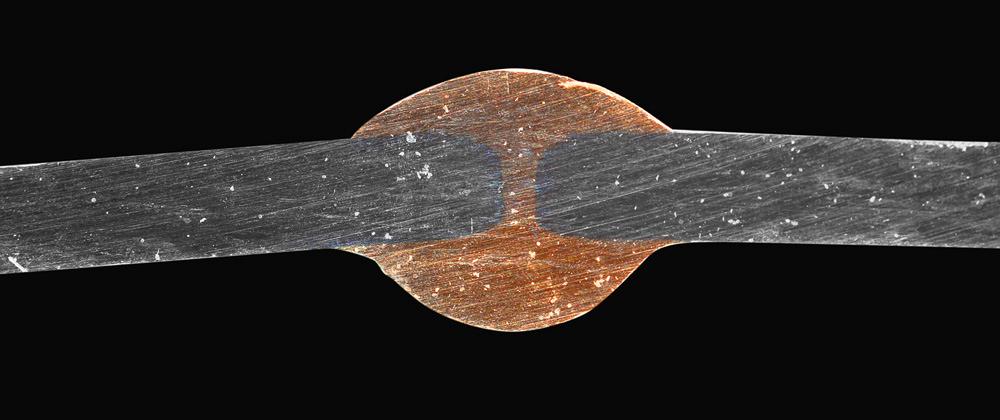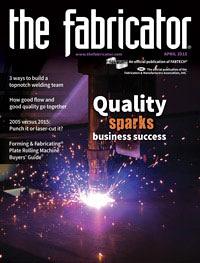Editor-in-Chief
- FMA
- The Fabricator
- FABTECH
- Canadian Metalworking
Categories
- Additive Manufacturing
- Aluminum Welding
- Arc Welding
- Assembly and Joining
- Automation and Robotics
- Bending and Forming
- Consumables
- Cutting and Weld Prep
- Electric Vehicles
- En Español
- Finishing
- Hydroforming
- Laser Cutting
- Laser Welding
- Machining
- Manufacturing Software
- Materials Handling
- Metals/Materials
- Oxyfuel Cutting
- Plasma Cutting
- Power Tools
- Punching and Other Holemaking
- Roll Forming
- Safety
- Sawing
- Shearing
- Shop Management
- Testing and Measuring
- Tube and Pipe Fabrication
- Tube and Pipe Production
- Waterjet Cutting
Industry Directory
Webcasts
Podcasts
FAB 40
Advertise
Subscribe
Account Login
Search
Synchronized welding
Redesigned GMAW equipment leads to cleaner welds, higher productivity
- By Dan Davis
- May 7, 2015
- Article
- Arc Welding

Figure 1
The new LSC dip transfer arc characteristics are suitable for root passes, fillet welds, corner welds, lap joints, filler passes, final runs, and brazing. In this picture, a brazed butt joint was done using the LSC Braze mode on 0.039- in. (1-mm) electrogalvanized steel using a 0.039-in. (1-mm) filler wire.
Gas metal arc welding (GMAW) has come a long way over the past decades. The computing power and finely tuned components of modern power sources help to deliver precise control of welding arc parameters.
But even with the advancements in welding technology, GMAW power sources still have their limits, which usually are linked to the skills of the welder using the equipment. And when that welder is presented with challenging jobs, such as welding out of position or working with thin materials, the job of producing a quality joint becomes even more reliant on skill.
Fronius has taken steps to boost the usefulness of its GMAW technology, the TPS/i system, for these difficult applications. The company’s engineers have redesigned the equipment and components and synchronized them to work together; the system is able to process much more data than the previous generation of equipment. For instance, the use of complicated auxiliary components, such as a separate cable to measure voltage, is not required with the new system.
Traditional dip transfer arc welding modes are associated with a high amount of spatter ejection. The new LSC (for low spatter control) welding platform is able to reduce spatter by 75 percent, according to the company.
Fronius officials said a welding trial involving 0.197-in. (5-mm) steel done at a speed of 236.219 IPM (6 m/min.) revealed that the traditional dip transfer arc process resulted in 0.075 oz. (2.14 g) of spatter per weld seam per 39.375 in. (1 m). The same welding trial showed that the LSC platform generated 0.019 oz. (0.54 g) per 39.375 in. (1 m).
The higher arc stability that helps reduce spatter also assists with root pass welding that has to be performed in a downward or upward direction. No one doubts that GMAW is the fastest way to lay a root seam in a downward position, especially when compared to shielded metal arc welding and gas tungsten arc welding. Using the conventional dip transfer arc model and working in a downward position, the experienced welder can produce that root seam at a rate of up to 9.844 IPM (25 cm/min.). However, a great risk of incomplete fusion exists because of the low arc pressure and the falling of the weld pool. Typically, this has been addressed by executing the root pass in an upward manner. Additionally, welding has to be performed using a colder welding parameter and at half the speed as in the downward motion. The weld seam also must be clean to counteract the risk of a lack of fusion.
The LSC Root welding mode addresses these shortcomings. The mode’s high arc pressure and deposition rate allow the welder to apply the root pass in a downward direction and not worry about drop-through (see Figure 1). If the LSC Root Advanced version is used, the weld seam can be welded at 9.844 IPM (25 cm/min.).
Fronius engineers reported that welders would see improvements in several other areas as well with this new platform:
- Longer hosepacks that are often used in container and pipeline construction and robotic welding can cause problems during GMAW. These longer cables have higher inductivity, and the higher the inductance in the welding circuit, the longer it takes for the current flow to be reduced. This means that if a short-circuit break occurs, the current cannot be reduced in time, resulting in spatter. The LSC Root Advanced (see Figure 2) and LSC Universal Advanced welding modes make use of additional hardware that allows the power source to open the circuit and decrease the current extremely fast. The longer cables used with these welding modes are designed to lead to spatter-free welding.
- A new wire feed speed control keeps the wire penetration constant during stick-out fluctuations, which is important for fillet welds that are made in the vertical-up position with an oscillating motion (see Figure 3). Without this constant wire feed—or penetration stabilizer, as Fronius calls it—the penetration would fluctuate between a maximum (short stick-out) and minimum (long stick-out) value with the oscillating motion. The stabilizer compensates for this fluctuation by readjusting the wire feed speed control, up to a maximum of 390 IPM (10 m/min.). This deep and even penetration would prove useful for welding difficult-to-reach seams or in robotic welding where change in the contact distance is often unavoidable.
- A new current profile is said to improve dynamic and arc length correction features. When laying a root pass, the welder can rely on the dynamic correction feature to adjust the arc pressure quickly, resulting in more reliable metal deposition. The arc length correction feature, which is generally used to set the arc to the shortest possible length, ensures that deep penetration is occurring, while avoiding undercutting. This also assists in maintaining higher welding speeds.
- Enhanced functions have been included in the LSC platform to assist in the creation of stitch welds and very short weld seams. The ignition energy of the TPS/i is no longer guided by an average value; instead, it is determined by the actual temperature of the wire end. Depending on when the last ignition occurred, the system adjusts the ignition current and its duration accordingly for each ignition. The company says the result is cleaner and higher-quality stitch welds. At the end of the weld, the wire is retracted, which prevents droplets from forming on the end of the wire.
About the Author

Dan Davis
2135 Point Blvd.
Elgin, IL 60123
815-227-8281
Dan Davis is editor-in-chief of The Fabricator, the industry's most widely circulated metal fabricating magazine, and its sister publications, The Tube & Pipe Journal and The Welder. He has been with the publications since April 2002.
Related Companies
subscribe now

The Fabricator is North America's leading magazine for the metal forming and fabricating industry. The magazine delivers the news, technical articles, and case histories that enable fabricators to do their jobs more efficiently. The Fabricator has served the industry since 1970.
start your free subscription- Stay connected from anywhere

Easily access valuable industry resources now with full access to the digital edition of The Fabricator.

Easily access valuable industry resources now with full access to the digital edition of The Welder.

Easily access valuable industry resources now with full access to the digital edition of The Tube and Pipe Journal.
- Podcasting
- Podcast:
- The Fabricator Podcast
- Published:
- 04/16/2024
- Running Time:
- 63:29
In this episode of The Fabricator Podcast, Caleb Chamberlain, co-founder and CEO of OSH Cut, discusses his company’s...
- Industry Events
16th Annual Safety Conference
- April 30 - May 1, 2024
- Elgin,
Pipe and Tube Conference
- May 21 - 22, 2024
- Omaha, NE
World-Class Roll Forming Workshop
- June 5 - 6, 2024
- Louisville, KY
Advanced Laser Application Workshop
- June 25 - 27, 2024
- Novi, MI
































